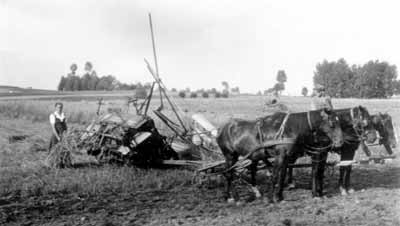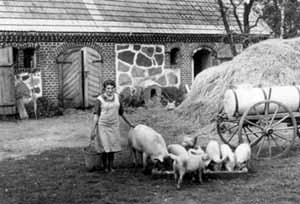 |
 |

|
Earning a Living |
|
|
In 1622 a Polish publication gives the minimum life stock for a "hollaender" farm as: 6 horses, 7 cows, 6 sheep and 6 pigs. So the German settlers seem to have been well-off. But continued divisions of the estates led to smaller and smaller farms. The emigrations of the German settlers and their moving eastward were really motivated by economic reasons. But what did the German settlers along the Vistula do to earn a living? According to Albert Breyer the economic system in all the villages along the Vistula was very much the same. It was stock farming, dairy farming and fruit growing. |
|

Reaper - Photo by: unknown photographer, around 1935 |
|
|
Stock farming and dairy farming was obvious because the banks and the islands of the Vistula offered enough meadows. The growing of fruits, especially plums and apples, was an additional source of income. The fruits were kiln-dried and sold and delivered in winter. In good years the income from selling dried fruits was higher than the income from the other sectors. Grain and potatoes were grown only for personal needs. |
|
|
In the rural environment few people lived from handicraft only. The farmers did the repairs of their houses and tools for themselves. Exceptions were millers and smiths and of course the host of the local pub who also offered a limited range of dry goods. In the Dobriner Land the settlers tilled the rooted soil and bread cattle and horses. |

Pig's meal - Photo by: unknown photographer, around 1935 |
|
Sources: Emil Mielke: Schlonsk; Albert Breyer: Deutsche Gaue in Mittelpolen; Karl Tomm: Wintereinnahmen aus dem Obstgarten des Weichselbauern, in: Der Heimatbote, Heft 1, 1963 |
|